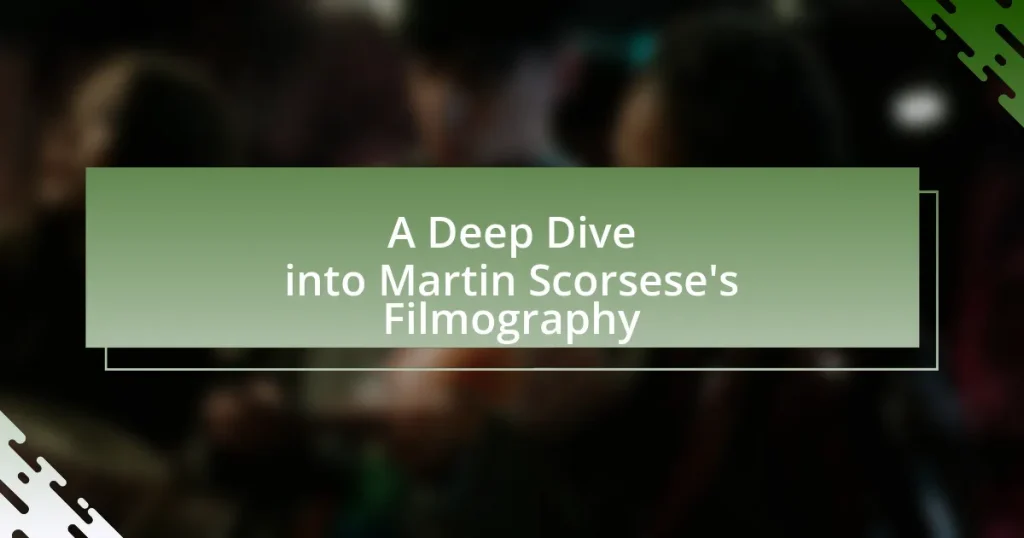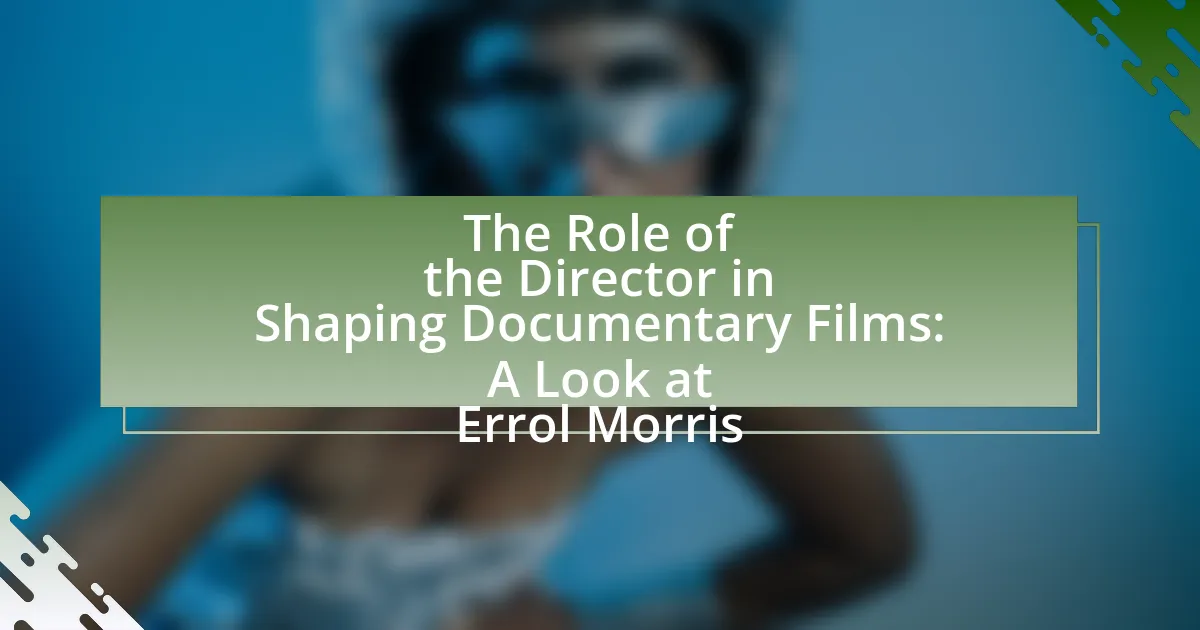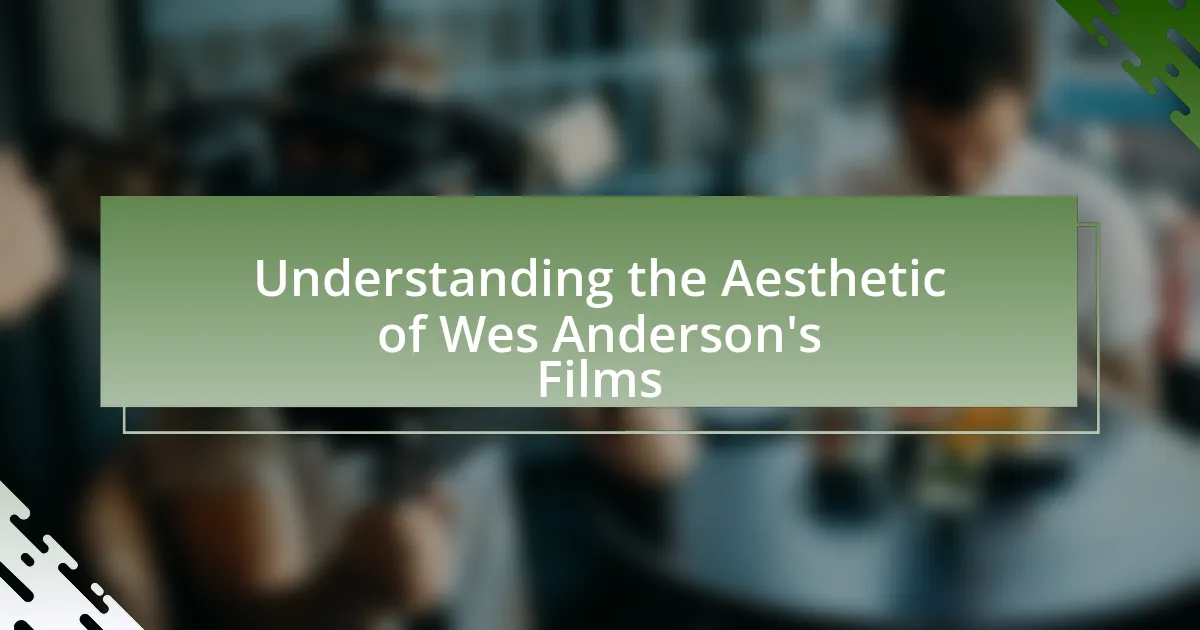Martin Scorsese’s filmography is characterized by its exploration of crime, morality, and the human condition, often featuring complex antiheroes and innovative storytelling techniques. The article examines the evolution of Scorsese’s directorial style, key elements such as dynamic camera movements and music integration, and the personal experiences that inform his themes. It highlights significant films like “Taxi Driver,” “Goodfellas,” and “The Irishman,” discussing their impact on cinema and culture, as well as Scorsese’s collaborations with actors and crew. Additionally, the article addresses the critical reception of his work, the lessons aspiring filmmakers can learn from his techniques, and the lasting influence he has had on contemporary filmmakers.
What defines Martin Scorsese’s filmography?
Martin Scorsese’s filmography is defined by its exploration of themes such as crime, morality, and the human condition, often set against the backdrop of urban environments. His films frequently feature complex characters, particularly antiheroes, and employ innovative storytelling techniques, including non-linear narratives and extensive use of music to enhance emotional impact. Scorsese’s collaboration with actors like Robert De Niro and Leonardo DiCaprio has resulted in iconic performances that further solidify his reputation as a master filmmaker. Notable works such as “Taxi Driver,” “Goodfellas,” and “The Irishman” exemplify his distinctive style and thematic preoccupations, making him a pivotal figure in American cinema.
How has Scorsese’s style evolved over the years?
Martin Scorsese’s style has evolved from gritty realism in his early works to a more expansive and stylistically diverse approach in his later films. Initially, Scorsese focused on themes of violence and morality, as seen in “Mean Streets” (1973) and “Taxi Driver” (1976), utilizing handheld camera work and a raw aesthetic to convey the struggles of marginalized characters. Over the years, his style incorporated more sophisticated narrative structures and visual techniques, evident in films like “Goodfellas” (1990) and “The Irishman” (2019), where he employed digital de-aging technology and a more reflective storytelling approach. This evolution reflects Scorsese’s adaptation to changing cinematic landscapes while maintaining his core themes of identity, guilt, and redemption.
What are the key elements of Scorsese’s directorial style?
The key elements of Scorsese’s directorial style include dynamic camera movements, intricate character development, and a strong emphasis on music. Scorsese often employs techniques such as tracking shots and rapid editing to create a sense of urgency and immersion in his films, exemplified in “Goodfellas” with its famous long take. His characters are typically complex and morally ambiguous, reflecting the struggles of identity and redemption, as seen in “Taxi Driver.” Additionally, Scorsese’s use of music is pivotal; he meticulously selects soundtracks that enhance emotional resonance, notably in “Mean Streets,” where rock music underscores the narrative’s tone. These elements collectively define his distinctive approach to storytelling in cinema.
How do themes in Scorsese’s films reflect his personal experiences?
Themes in Scorsese’s films often reflect his personal experiences, particularly his upbringing in New York City and his Italian-American heritage. Scorsese frequently explores themes of identity, guilt, and redemption, which are influenced by his own struggles with faith and morality, as seen in films like “Mean Streets” and “Taxi Driver.” For instance, the character of Travis Bickle in “Taxi Driver” embodies Scorsese’s feelings of alienation and disconnection, mirroring his own experiences growing up in a turbulent environment. Additionally, the depiction of organized crime in films such as “Goodfellas” and “Casino” draws from Scorsese’s observations of the Italian-American community, reflecting both admiration and critique of that world. These thematic elements serve as a lens through which Scorsese processes his past, making his films deeply personal and autobiographical.
What are the most significant films in Scorsese’s career?
The most significant films in Martin Scorsese’s career include “Taxi Driver,” “Raging Bull,” “Goodfellas,” “The Departed,” and “Casino.” “Taxi Driver,” released in 1976, is a landmark film that explores themes of isolation and violence, earning Scorsese his first Academy Award nomination for Best Director. “Raging Bull,” released in 1980, is widely regarded as one of the greatest films ever made, showcasing Scorsese’s mastery of storytelling and character development, and it won two Academy Awards. “Goodfellas,” released in 1990, is a seminal crime film that received six Academy Award nominations and is praised for its realistic portrayal of mob life. “The Departed,” released in 2006, won Scorsese his first Academy Award for Best Director and is notable for its intricate plot and strong performances. “Casino,” released in 1995, further explores the themes of greed and betrayal within the context of organized crime. Each of these films has significantly impacted cinema and solidified Scorsese’s reputation as a master filmmaker.
Which films are considered his masterpieces?
Martin Scorsese’s masterpieces include “Taxi Driver,” “Raging Bull,” “Goodfellas,” “The Departed,” and “The Irishman.” These films are widely regarded as significant contributions to cinema, showcasing Scorsese’s unique storytelling and directorial style. “Taxi Driver” (1976) is noted for its exploration of urban alienation, while “Raging Bull” (1980) is acclaimed for its intense character study and innovative cinematography. “Goodfellas” (1990) is celebrated for its realistic portrayal of organized crime, and “The Departed” (2006) won the Academy Award for Best Picture, highlighting its critical success. “The Irishman” (2019) is recognized for its ambitious narrative and use of de-aging technology, further solidifying Scorsese’s legacy in film history.
How do these films impact the film industry?
Martin Scorsese’s films significantly impact the film industry by redefining narrative techniques and elevating the status of filmmakers as artists. His innovative use of editing, such as in “Goodfellas,” which popularized the use of voice-over narration and non-linear storytelling, has influenced countless filmmakers and altered mainstream cinematic practices. Additionally, Scorsese’s commitment to character-driven stories and complex moral themes has set a benchmark for storytelling, encouraging studios to invest in more sophisticated narratives. The critical and commercial success of his films, including “The Irishman,” has demonstrated the viability of long-form storytelling in cinema, leading to a trend where streaming platforms prioritize high-quality, feature-length films.
What recurring themes can be found in Scorsese’s work?
Recurring themes in Martin Scorsese’s work include violence, guilt, redemption, and the exploration of identity. Scorsese often portrays characters grappling with their moral choices, as seen in films like “Taxi Driver” and “Goodfellas,” where protagonists face the consequences of their violent actions. The theme of guilt is prevalent in “Raging Bull,” where the main character’s internal struggles lead to self-destruction. Redemption is a significant aspect in “The Departed,” highlighting the complexities of loyalty and betrayal. Additionally, Scorsese frequently examines cultural identity, particularly in the context of Italian-American experiences, as illustrated in “Mean Streets.” These themes are consistently woven throughout his filmography, reflecting his deep understanding of human nature and societal issues.
How does Scorsese portray violence in his films?
Martin Scorsese portrays violence in his films as a complex and multifaceted element that serves to explore themes of power, morality, and the human condition. His depiction often combines visceral realism with stylistic choices, such as slow-motion sequences and intense sound design, to heighten the emotional impact of violent scenes. For instance, in “Taxi Driver,” the violence reflects the protagonist’s psychological turmoil and societal alienation, while in “Goodfellas,” it illustrates the brutal realities of mob life and the consequences of a violent lifestyle. Scorsese’s films frequently use violence not merely for shock value but as a narrative device that reveals character motivations and societal critiques, making it integral to the storytelling process.
What role does religion play in Scorsese’s storytelling?
Religion plays a central role in Martin Scorsese’s storytelling, often serving as a lens through which he explores themes of morality, guilt, and redemption. Scorsese’s films, such as “Mean Streets,” “The Last Temptation of Christ,” and “Silence,” reflect his Catholic upbringing and the profound impact of faith on human experience. In “The Last Temptation of Christ,” for instance, Scorsese delves into the internal struggles of Jesus, highlighting the conflict between divine purpose and human desire, which underscores the complexity of faith. Additionally, “Silence” examines the silence of God in the face of suffering, prompting viewers to confront their own beliefs. These examples illustrate how Scorsese uses religion not only as a thematic element but also as a narrative device that shapes character motivations and moral dilemmas, reinforcing the significance of spiritual inquiry in his body of work.

How does Martin Scorsese collaborate with actors and crew?
Martin Scorsese collaborates with actors and crew through a highly interactive and immersive process that emphasizes communication and trust. He often engages in extensive pre-production discussions with actors to develop their characters deeply, as seen in films like “Raging Bull” and “Goodfellas,” where he encourages improvisation and personal input from the cast. Scorsese also fosters a collaborative environment on set, allowing crew members to contribute creatively, which enhances the overall filmmaking experience. His long-standing partnerships with actors such as Robert De Niro and Leonardo DiCaprio exemplify this collaborative approach, as they share a mutual understanding and respect that enriches their performances and the film’s narrative.
What is the significance of Scorsese’s collaborations with certain actors?
The significance of Scorsese’s collaborations with certain actors lies in the depth and authenticity they bring to his films. Scorsese frequently works with actors like Robert De Niro and Leonardo DiCaprio, creating a unique synergy that enhances character development and storytelling. For instance, De Niro’s performances in films such as “Taxi Driver” and “Raging Bull” showcase a profound exploration of complex characters, which has become a hallmark of Scorsese’s style. Similarly, DiCaprio’s roles in “The Wolf of Wall Street” and “Shutter Island” reflect a dynamic range that complements Scorsese’s narrative vision. These collaborations not only elevate the films but also contribute to the actors’ careers, establishing them as iconic figures in cinema. The recurring partnerships demonstrate a mutual understanding and trust, allowing for innovative storytelling that resonates with audiences.
How have actors like Robert De Niro and Leonardo DiCaprio influenced his films?
Robert De Niro and Leonardo DiCaprio have significantly influenced Martin Scorsese’s films through their powerful performances and collaborative synergy. De Niro’s work in films like “Taxi Driver” and “Raging Bull” established a benchmark for character depth and intensity, shaping Scorsese’s narrative style and thematic focus on complex antiheroes. Similarly, DiCaprio’s roles in “Gangs of New York,” “The Aviator,” and “The Wolf of Wall Street” have allowed Scorsese to explore contemporary issues and moral ambiguity, enhancing the emotional resonance of his storytelling. Their collaborations have not only garnered critical acclaim but have also contributed to the evolution of Scorsese’s directorial vision, making them integral to his filmography.
What unique contributions do cinematographers bring to Scorsese’s projects?
Cinematographers bring a distinctive visual language to Scorsese’s projects, enhancing storytelling through composition, lighting, and camera movement. Their expertise in creating mood and atmosphere is evident in films like “Goodfellas,” where Michael Ballhaus’s dynamic camera work immerses viewers in the frenetic energy of the narrative. Additionally, the collaboration with cinematographers like Rodrigo Prieto in “Silence” showcases the ability to convey complex themes through visual symbolism and nuanced lighting, reinforcing the emotional depth of the story. This synergy between Scorsese and his cinematographers results in a unique aesthetic that elevates the cinematic experience.
How does Scorsese’s choice of music enhance his films?
Scorsese’s choice of music significantly enhances his films by creating emotional depth and establishing a strong sense of time and place. His meticulous selection of tracks, often from various genres and eras, complements the narrative and character development, making scenes more impactful. For instance, in “Goodfellas,” the use of classic rock and pop songs not only sets the tone but also reflects the characters’ lifestyles and the era’s cultural backdrop. This approach is evident in his collaboration with music supervisor Robbie Robertson, who has helped curate soundtracks that resonate with the film’s themes. Scorsese’s integration of music serves as a storytelling device, enriching the viewer’s experience and reinforcing the emotional stakes within the narrative.
What role does music play in setting the tone of his films?
Music plays a crucial role in setting the tone of Martin Scorsese’s films by enhancing emotional depth and reinforcing narrative themes. Scorsese meticulously selects music that aligns with the characters’ experiences and the film’s atmosphere, often using popular songs from the era depicted to evoke nostalgia and authenticity. For instance, in “Goodfellas,” the use of classic rock tracks not only establishes the time period but also mirrors the characters’ emotional states, creating a visceral connection with the audience. This strategic integration of music has been recognized as a defining characteristic of Scorsese’s style, contributing significantly to the overall impact and memorability of his films.
How does Scorsese select the soundtracks for his movies?
Martin Scorsese selects soundtracks for his movies by deeply integrating music that reflects the emotional tone and historical context of the film. He often chooses songs that resonate with the characters’ experiences and the narrative’s themes, utilizing a mix of popular music and classical scores. For instance, in “Goodfellas,” Scorsese employed a diverse range of rock and pop songs from the 1960s and 1970s to enhance the film’s atmosphere and authenticity, showcasing his meticulous attention to detail in music selection. This approach not only supports the storytelling but also evokes nostalgia and connects viewers to the film’s setting.

What impact has Martin Scorsese had on cinema and culture?
Martin Scorsese has profoundly influenced cinema and culture through his innovative storytelling techniques and exploration of complex themes. His films, such as “Taxi Driver,” “Goodfellas,” and “The Irishman,” have redefined narrative structures and character development, often delving into the darker aspects of human nature and morality. Scorsese’s use of music, particularly in “Mean Streets” and “Casino,” has set new standards for soundtracks in film, enhancing emotional resonance and cultural context. Additionally, his advocacy for film preservation and education has significantly impacted the film industry, as evidenced by his founding of The Film Foundation in 1990, which aims to protect and preserve cinematic history. Through these contributions, Scorsese has not only shaped the landscape of modern filmmaking but has also left an indelible mark on global culture, influencing countless filmmakers and artists worldwide.
How has Scorsese influenced contemporary filmmakers?
Martin Scorsese has significantly influenced contemporary filmmakers through his innovative storytelling techniques and mastery of character development. His use of complex narratives, often featuring anti-heroes, has inspired filmmakers like Quentin Tarantino and David O. Russell to explore morally ambiguous characters and intricate plots. Scorsese’s emphasis on authenticity and cultural context in films such as “Goodfellas” and “The Irishman” has encouraged a new generation to prioritize realism and historical accuracy in their storytelling. Additionally, his collaboration with actors and musicians has set a standard for integrating performance and sound, influencing directors like Damien Chazelle and Greta Gerwig to focus on strong character arcs and emotional depth in their works.
What techniques have been adopted by modern directors from Scorsese’s work?
Modern directors have adopted several techniques from Martin Scorsese’s work, including the use of dynamic editing, voiceover narration, and complex character development. Scorsese’s dynamic editing style, characterized by rapid cuts and rhythmic pacing, has influenced films like “Birdman” by Alejandro González Iñárritu, which employs similar techniques to create a sense of urgency and immersion. Additionally, the use of voiceover narration, as seen in Scorsese’s “Goodfellas,” has been embraced by directors such as Wes Anderson in “The Royal Tenenbaums,” allowing for deeper insight into characters’ thoughts and motivations. Furthermore, Scorsese’s focus on morally ambiguous characters has inspired filmmakers like Quentin Tarantino, who often explores complex character arcs in films like “Pulp Fiction.” These techniques highlight Scorsese’s lasting impact on contemporary cinema.
How does Scorsese’s storytelling resonate with today’s audiences?
Scorsese’s storytelling resonates with today’s audiences through its exploration of complex characters and moral ambiguity. His films often reflect contemporary societal issues, such as crime, identity, and the human condition, making them relatable to modern viewers. For instance, “The Irishman” addresses themes of aging and regret, which resonate with an audience grappling with similar existential questions. Additionally, Scorsese’s innovative use of narrative techniques, such as non-linear storytelling and breaking the fourth wall, engages audiences in a way that feels fresh and relevant. His ability to blend personal stories with broader cultural critiques ensures that his work remains impactful and thought-provoking in today’s cinematic landscape.
What are the critical receptions of Scorsese’s films?
Martin Scorsese’s films have received widespread critical acclaim, often being hailed as masterpieces of cinema. His works, such as “Taxi Driver,” “Goodfellas,” and “The Irishman,” have garnered numerous awards, including Academy Awards, Golden Globes, and BAFTAs, reflecting their impact and recognition in the film industry. Critics frequently praise Scorsese for his innovative storytelling, complex characters, and distinctive visual style, which have influenced generations of filmmakers. For instance, “Goodfellas” is often cited as one of the greatest films ever made, receiving a 96% approval rating on Rotten Tomatoes, indicating its enduring legacy and critical reception.
How have critics’ views on his films changed over time?
Critics’ views on Martin Scorsese’s films have evolved significantly over time, transitioning from initial skepticism to widespread acclaim. Early in his career, films like “Mean Streets” and “Taxi Driver” received mixed reviews, with some critics questioning their violent content and themes. However, as Scorsese’s body of work expanded, particularly with masterpieces such as “Goodfellas” and “The Departed,” critics began to recognize his unique storytelling style and directorial prowess, leading to numerous accolades, including Academy Awards. By the 2000s, Scorsese was celebrated as one of the greatest filmmakers, with retrospective reviews often highlighting the depth and complexity of his earlier works, thus solidifying his legacy in cinema history.
What awards and recognitions has Scorsese received throughout his career?
Martin Scorsese has received numerous prestigious awards and recognitions throughout his career, including the Academy Award for Best Director for “The Departed” in 2007. Additionally, he has won multiple Golden Globe Awards, BAFTA Awards, and the AFI Life Achievement Award. Scorsese is also a recipient of the Directors Guild of America Lifetime Achievement Award and the Kennedy Center Honors, highlighting his significant contributions to the film industry. His films have garnered critical acclaim, with several being included in the American Film Institute’s list of the greatest American films.
What can aspiring filmmakers learn from Martin Scorsese’s filmography?
Aspiring filmmakers can learn the importance of character development and narrative complexity from Martin Scorsese’s filmography. Scorsese’s films, such as “Goodfellas” and “Taxi Driver,” showcase multi-dimensional characters whose arcs drive the story forward, emphasizing the need for depth in character creation. Additionally, his use of innovative storytelling techniques, including non-linear narratives and voiceovers, illustrates how filmmakers can engage audiences through unique perspectives. Scorsese’s meticulous attention to detail in cinematography and sound design further highlights the significance of technical craftsmanship in filmmaking, as seen in “The Irishman,” where visual style enhances the narrative.
What are the key lessons in storytelling from Scorsese’s films?
Key lessons in storytelling from Scorsese’s films include the importance of character complexity, moral ambiguity, and the exploration of themes such as guilt and redemption. Scorsese often crafts multi-dimensional characters, as seen in “Taxi Driver,” where Travis Bickle’s psychological depth drives the narrative. His films frequently present morally ambiguous situations, exemplified in “Goodfellas,” where the allure of crime is juxtaposed with its consequences. Additionally, Scorsese’s focus on themes like guilt and redemption is evident in “The Departed,” where characters grapple with their past actions, reinforcing the idea that choices have lasting impacts. These elements contribute to rich, engaging narratives that resonate with audiences.
How can filmmakers apply Scorsese’s techniques in their own work?
Filmmakers can apply Scorsese’s techniques by incorporating his signature elements such as dynamic editing, character-driven narratives, and the use of music to enhance storytelling. For instance, Scorsese often employs rapid cuts and montages to create a sense of urgency and emotional impact, as seen in “Goodfellas.” Additionally, his focus on flawed, complex characters allows for deeper audience engagement, exemplified in “Taxi Driver.” Furthermore, Scorsese’s meticulous selection of music not only sets the tone but also reflects the characters’ inner lives, a technique evident in “Casino.” By studying these aspects, filmmakers can enrich their own storytelling and visual style.




